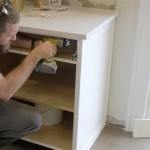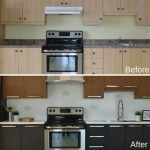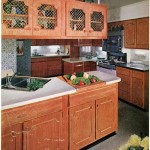Painting Over Wood Stained Kitchen Cabinets: A Comprehensive Guide
Rejuvenating your kitchen cabinets with a fresh coat of paint is a popular and cost-effective way to transform your space. However, if you're dealing with wood-stained cabinets, the process requires special considerations to ensure a successful outcome.
In this guide, we will explore the essential aspects of painting over wood-stained kitchen cabinets, addressing key steps, techniques, and common challenges. Whether you're a seasoned DIYer or a novice painter, this comprehensive guide will empower you to tackle this project with confidence.
1. Preparation: The Foundation for Success
Preparing your cabinets for painting is paramount. Begin by thoroughly cleaning them with a degreasing cleaner to remove dirt, grease, and grime. Sand any rough or uneven surfaces with fine-grit sandpaper, removing any remaining stains or imperfections. Finally, wipe down the cabinets with a tack cloth to eliminate any dust or debris.
2. Choosing the Right Paint and Primer
Selecting the appropriate paint and primer is crucial for a long-lasting and professional finish. Opt for a high-quality, oil-based primer specifically designed for bonding to wood and blocking stains. For the topcoat, choose a durable paint with a finish that suits your desired aesthetic and the kitchen environment. Satin or semi-gloss finishes offer a balance of durability and ease of cleaning.
3. Applying the Primer and Paint
Apply the primer in a thin, even coat, using a brush or roller. Allow the primer to dry completely before applying the topcoat paint. Once dry, apply the paint in multiple thin layers, allowing each layer to dry thoroughly before applying the next. Use a brush or roller to achieve a smooth and even finish.
4. Dealing with Common Challenges
Bleed-Through: Stains may bleed through the paint, especially if the wood is heavily stained. Apply multiple coats of primer and use a stain-blocking primer to prevent this issue.
Brush Strokes: Avoid visible brush strokes by using a high-quality paintbrush, applying thin layers, and brushing in the direction of the wood grain.
Sagging and Dripping: Avoid sags and drips by applying thin coats of paint and allowing each coat to dry completely. Use a brush to control the paint flow and avoid over-brushing.
5. Finishing and Protecting
Once the paint is dry, protect the surface with a clear topcoat. Choose a polyurethane or varnish specifically designed for kitchen cabinets. Apply in thin layers, allowing each layer to dry completely. The topcoat adds durability and protects against wear, moisture, and heat.
By following these essential aspects, you can confidently tackle the process of painting over wood-stained kitchen cabinets. Patience, precision, and proper preparation will lead to a stunning transformation that rejuvenates your kitchen and elevates its style.

Cabinet Refinishing Guide

Can I Paint Over Stained Wood Williams Painting

Painted Wood Cabinets Vs Stained A Questionnaire Kylie M Interiors

Avoid These Mistakes How To Paint Cabinets That Are Already Painted Grace In My Space

Steps In Painting Kitchen Cabinets That Are Stained Restoring

Farmhouse Check In A What We Chose Edition Stained Wood Or Painted Cabinets Emily Henderson

Painted Vs Stained Cabinets Which One To Choose Sir Paints A Lot

Painted Vs Stained Cabinets Jm Kitchen And Bath Design

How To Paint Veneer Cabinets For A Long Lasting Finish Anika S Diy Life

Kitchen Cabinet Color Should You Paint Or Stain








